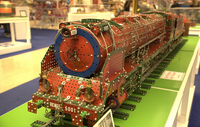








Meccano is a model construction system created in Liverpool, UK by Frank Hornby. It is now based in Calais, France.
It consists of re-usable metal strips, plates, angle girders, wheels, axles and gears, with nuts and bolts to connect the pieces. It enables the building of working models and mechanical devices.
The ideas for Meccano were first conceived by Hornby in 1898 and he developed and patented the construction kit as "Mechanics Made Easy" in 1901. The name was later changed to "Meccano" and manufactured by the British company, Meccano Ltd, between 1908 and 1980. It is now manufactured in France and China by Meccano S.N. of France, part of the Canadian Spin Master toy company. In the USA, Meccano is sold under the Erector Set brand.
First Meccano sets
In 1901 Frank Hornby, a clerk from Liverpool, England, invented and patented a new toy called "Mechanics Made Easy" that was based on the principles of mechanical engineering.It was a model construction kit consisting of perforated metal strips, plates and girders, with wheels, pulleys, gears, shaft collars and axles for mechanisms and motion, and nuts and bolts to connect the pieces. The perforations were at a standard ½ inch (12.7 mm) spacing, the axles were 8-gauge, and the nuts and bolts used 5/32 inch BSW threads. The only tools required to assemble models were a screwdriver and spanners (wrenches). It was more than just a toy: it was educational, teaching basic mechanical principles like levers and gearing.
The parts for Hornby's new construction kit were initially supplied by outside manufacturers, but as demand began to exceed supply, Hornby set up his own factory in Duke Street, Liverpool. As the construction kits gained in popularity they soon became known as Meccano and went on sale across the world. In September 1907, Hornby registered the Meccano trade mark, and in May 1908, he formed Meccano Ltd. To keep pace with demand, a new Meccano factory was built in Binns Road, Liverpool in 1914, which became Meccano Ltd's headquarters for the next 60 years. Hornby also established Meccano factories in France, Spain and Argentina. The word "Meccano" was thought to have been derived from the phrase "Make and Know".
The first construction sets had parts that were rather crudely made: the metal strips and plates had a tinplate finish, were not rounded at the ends and were not very sturdy. But manufacturing methods were improving all the time and by 1907 the quality and appearance had improved considerably: the metal strips were now made of thicker steel with rounded ends and were nickel-plated, while the wheels and gears were machined from brass.
The first sets under the new Meccano name were numbered 1 to 6. In 1922 the No. 7 Meccano Outfit was introduced, which was the largest set of its day, and the most sought after because of its model building capabilities and prestige.
In 1926, to mark the 25th anniversary of his patent, Hornby introduced "Meccano in Colours" with the familiar red and green coloured Meccano pieces. Initially plates were a light red and items like the braced girders were a pea-green. However, the following year strips and girders were painted dark green, the plates Burgundy red, while the wheels and gears remained brass. In 1934 the Meccano pieces changed colour again: the strips and girders became gold while the plates were changed to blue with gold criss-cross lines on them, but only on one side, the reverse remaining plain blue. This new colour scheme was only available in the United Kingdom until the end of the Second World War in 1945. The old red and green sets were still produced for the export market and were re-introduced in the UK after the war.
In 1958 the colours were changed slightly to what become known as 'light red and green' but this incarnation had the shortest lifespan as the colours changed dramatically in 1964 to the black and yellow colour scheme. However, this light red and green period did see the introduction of about 90 new parts, more modern packaging, a new cabinet was introduced for the number 10 set, the first plastic parts were introduced, and the "exploded diagram" instructions made their début.
Further developments
In 2013, Meccano launched "Meccano Evolution", a new "back to basics" iteration of Meccano, which allowed smaller and more detailed models to be built using simpler and more "functional" parts than were supplied in previous "new Meccano" sets. Meccano Evolution has narrower strips, with holes spaced at twice the density of the original system. In late 2013, the company also opened a public "Meccano Lab" play space and R&D centre, in Calais, France.
In 2015 Spin Master launched Meccanoids, Meccano modular robots.